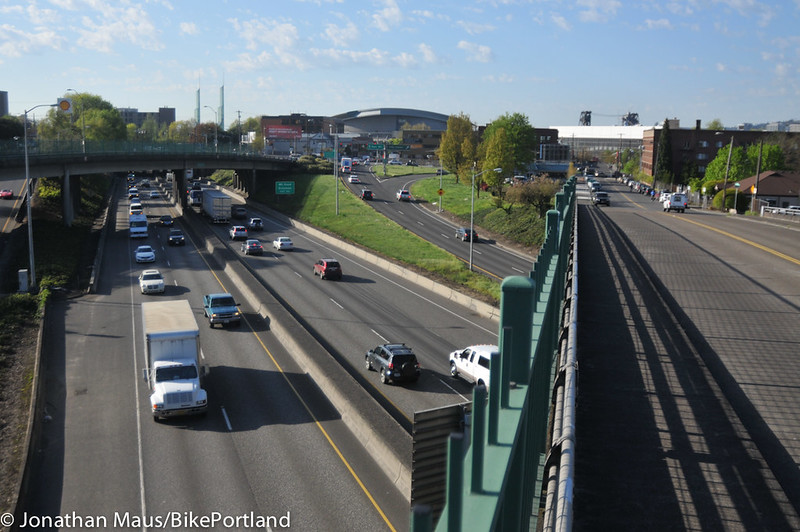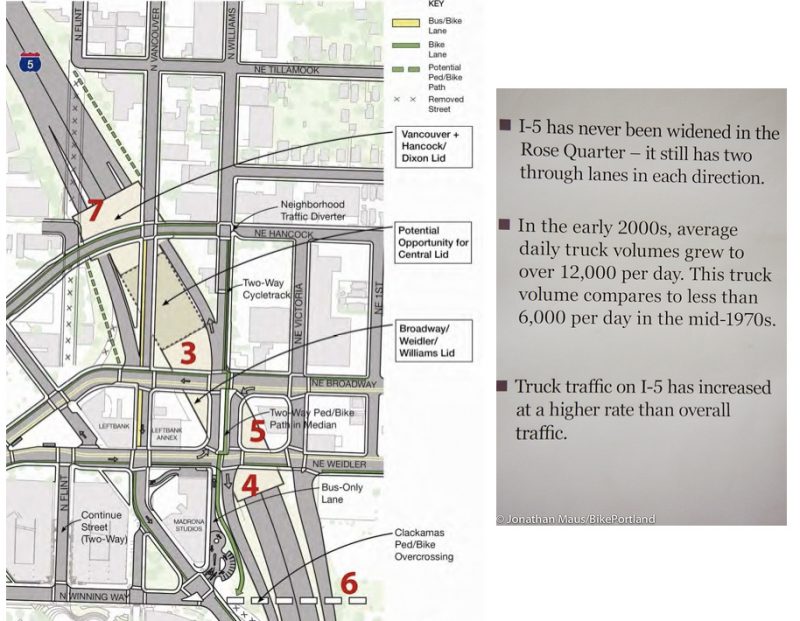
(Photo: J. Maus/BikePortland)
The initial draft of Oregon’s just-passed transportation bill was an audacious money-grab from misguided politicians and the freeway advocates that fuel them. Thankfully, the final version that Governor Kate Brown signed into law today in Portland dramatically scaled-back our investment in urban freeway widening projects; but not completely.
One of the winners in the bill was a project that will expand Interstate 5 through the Rose Quarter — right through the heart of Portland’s central city. And with City Council poised for a vote to add the project into Portland’s Transportation System Plan on September 7th, activists are laying the groundwork for another freeway fight.
How we got here

The Oregon Department of Transportation has drooled over widening I-5 through the Rose Quarter for decades. And surprisingly, they have the City of Portland’s support for it because they’d package it with local street improvements. ODOT sees the relatively narrow cross-section (it’s two lanes in each direction) as a major “bottleneck” for motor vehicle users. Plans on what to do about it have floated around since the 1980s and matured in 2007 with a report that laid the groundwork for the City of Portland’s N/NE Quadrant/I-5 Broadway Weidler project (completed in 2012). BikePortland was first to publish that report in 2010.
In a December 2010 editorial I warned that, “Without a strong community voice about how to — or if we should — move forward, some of the shockingly highway-centric concepts in that report could gain traction.”
Organized community pushback never materialized and by June 2012, the $400 million “I-5 Facility Plan” had taken shape. In addition to new lanes on I-5 between Interstate 84 and the Fremont Bridge, the plans included numerous changes to surface streets aimed at better bicycling and walking in the area. At the time, Eliot Neighborhood Association Land Use Chair and N/NE Quadrant project advisory committee member Mike Warwick told us, “The associated surface street improvements… while attractive, do not offset the obvious negative consequences of the freeway proposal.”
In September of that same year, Active Right of Way, a now-defunct group of volunteer activists, also issued a strong statement against the plans.
We didn’t hear much about the project until early this year when TriMet General Manager Neil McFarlane began stumping for the project to build support prior to the 2017 legislative session. McFarlane, head of a mass transit agency, inexplicably became the public face in support of widening I-5 and two other urban freeways in our region (in addition to “his” project, the SW Corridor).
Advertisement
“This expensive boondoggle will not adequately address our region’s congestion problems or the safety problems on the corridor as ODOT suggests, and will actively hurt our region’s ability to meet our carbon reduction goals, our air quality goals, our fiscal stewardship goals, and our equity goals of investing scarce resources in neighborhoods where they are needed the most.”
— Joe Cortright, City Observatory
As momentum continued for the project, Portland Planning Commissioner Chris Smith tried to get his colleagues on the Planning and Sustainability Commission to take the I-5 widening project out of the City of Portland’s Transportation System Plan. Smith’s hope was to force Portland City Council to have to take a vote on the project. That was back in March and Smith couldn’t get the votes he needed. “There are a huge number of good things this plan does and I don’t dispute that,” Smith said a commission meeting, “But neither can I ignore that the first thing it does is that it makes driving easier.”
Smith’s gambit inspired Bike Loud PDX to flood TriMet’s board meeting with testimony and signs opposing the project back in March.
With the project still very much alive (see below), activists’ new target is the public hearing on the Central City Plan slated for Portland City Council on September 7th. At that meeting, councilors will decide on whether or not to include the I-5 widening project (and others) in the plan.
Momentum thanks to House Bill 2017
It’s not as offensive as the $338 million investment lawmakers in Salem first proposed to widen the freeway; but the final version of HB 2017 still gave the project a huge lift. In a new FAQ, ODOT says the bill, “funds improvements on I-5 at the Rose Quarter, one of the worst bottlenecks for freight and passenger vehicles in the entire nation.” They also tout the project’s benefits to the safety and convenience of motor vehicle users: “Building the Rose Quarter project will improve safety and save more than 2.5 million hours of travel time each year.”
The bill itself mandates that the creation of a detailed cost analysis for the project — complete with “construction option packages” — must be completed by 2020. Once that analysis is done, the bill promises $30 million per year for the project starting in 2022. This support of the project in HB 2017 will give backers the momentum they need to find more money — likely from a big regional transportation funding bond being hammered out right now.
Signs of unrest
With this state support now enshrined by law and a big Portland City Council vote looming, activists seem to be getting organized in a way they haven’t been in the past.
Noted local economist Joe Cortright — also a chief critic of the Columbia River Crossing project — has been using his platform at City Observatory to voice strong opposition to the project. In an article explaining failed freeway projects in other cities posted last week, Cortright wrote that the I-5 project is an, “expensive boondoggle [that] will not adequately address our region’s congestion problems or the safety problems on the corridor as ODOT suggests, and will actively hurt our region’s ability to meet our carbon reduction goals, our air quality goals, our fiscal stewardship goals, and our equity goals of investing scarce resources in neighborhoods where they are needed the most.”
Cortright has also ripped ODOT’s safety claims, saying the agency’s own “performance report” puts driving convenience over public health and is based on analysis that people should be driving 60 mph through Portland — which is five miles over the legal limit. He also questioned ODOT’s main promise: That widening freeways is the best way to improve congestion.
And Cortright isn’t alone. As we’ve seen with Active Right of Way and Bike Loud PDX — and the groups that came before them to defeat the Mt. Hood Freeway — there’s widespread grassroots opposition to freeway widening projects in Portland.
On September 7th, local independnet activist Aaron Brown is will lead a march to City Hall as part of Oregon Walks’ month-long celebration of walking called “Steptember”. “Join a rabblerousing group of citizen advocates,” says the event description, “as we walk from the Tom McCall Waterfront Park (where Portlanders forty years ago tore out a highway!) before walking to City Hall to testify in opposition to the freeway expansion project.”
This is about to get much more interesting. Stay tuned.
UPDATE, 8/30 at 9:05 am: The No More Freeways coalition has launched with a letter to Portland City Council. Read all about it in our latest post.
— Jonathan Maus: (503) 706-8804, @jonathan_maus on Twitter and jonathan@bikeportland.org
Never miss a story. Sign-up for the daily BP Headlines email.
BikePortland needs your support.


